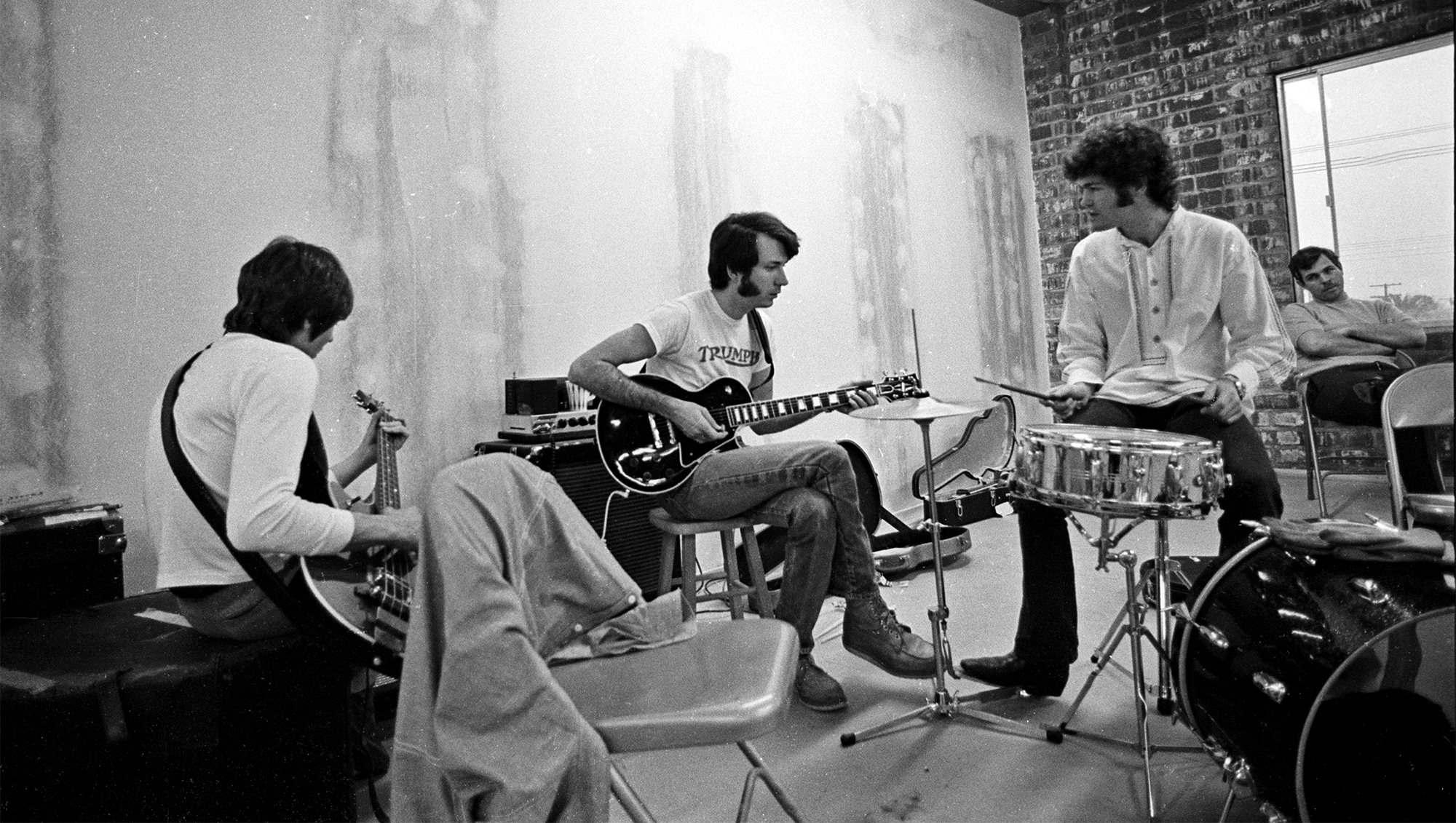"Every once in a while you’ll hear him fret some unexpected chord you didn’t know existed." Behind Doug Gillard's six-string wizardry for alt-rock faves Guided by Voices and Nada Surf.
His band mates call his guitar talents "indispensable." But all Gillard wants is to make good music.
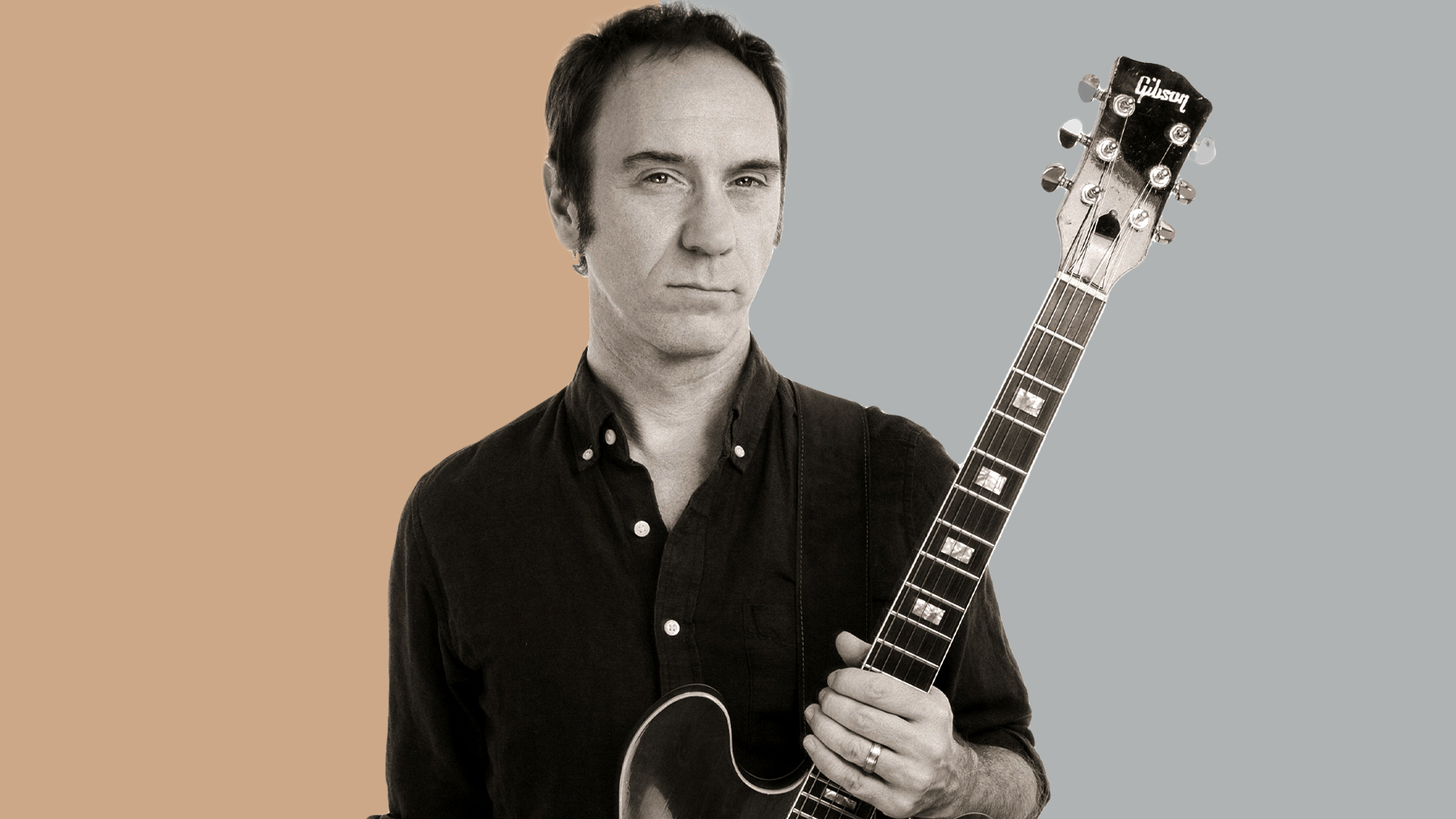
If you’re a regular at Guided by Voices shows — and most of the band’s rabid fans have seen the group dozens, if not hundreds, of times — you’ll know what to expect when you turn your gaze stage left: lead guitarist Doug Gillard, legs apart, feet firmly planted on the ground, heavily worn black Les Paul Custom slung over his shoulder, while an equally well-used Mesa Dual Rectifier blasts out the cascading licks, signature riffs and tightly clustered chord voicings that have made him one of indie rock’s most celebrated players and landed him on Rolling Stone’s list of “The 250 Greatest Guitarists of All Time.”
“Doug is original and also diverse in technique,” says Robert Pollard, Guided by Voices’ frontman and principal songwriter. “He can let loose when he wants to, but he doesn’t wank. He shows restraint, and his playing compliments the songs.” Since first catching Pollard’s attention in the 1980s while playing in the Cleveland group Death of Samantha, Gillard (who also played with Ohioan provocateurs Cobra Verde) has done two tours of duty in Guided by Voices: the first from 1996 to the group’s “retirement” at the end of 2004, and again from 2016 to the present.
In the interim, Gillard spent more than five years touring and recording extensively with alternative-rock group Nada Surf. “We’d always admired Doug’s playing from a distance,” Nada Surf frontman Matthew Caws says. “But when we met and he sat in on a couple of songs as a guest on our 2010 covers album, If I Had a Hi-Fi, he made up parts so catchy that within half an hour he felt indispensable.”
Gillard has also released several solo efforts, including 2014’s excellent Parade On, produced albums by the Eternal Summers and others, and contributed to discs by artists as diverse as Neko Case, the Mice and the Hold Steady.
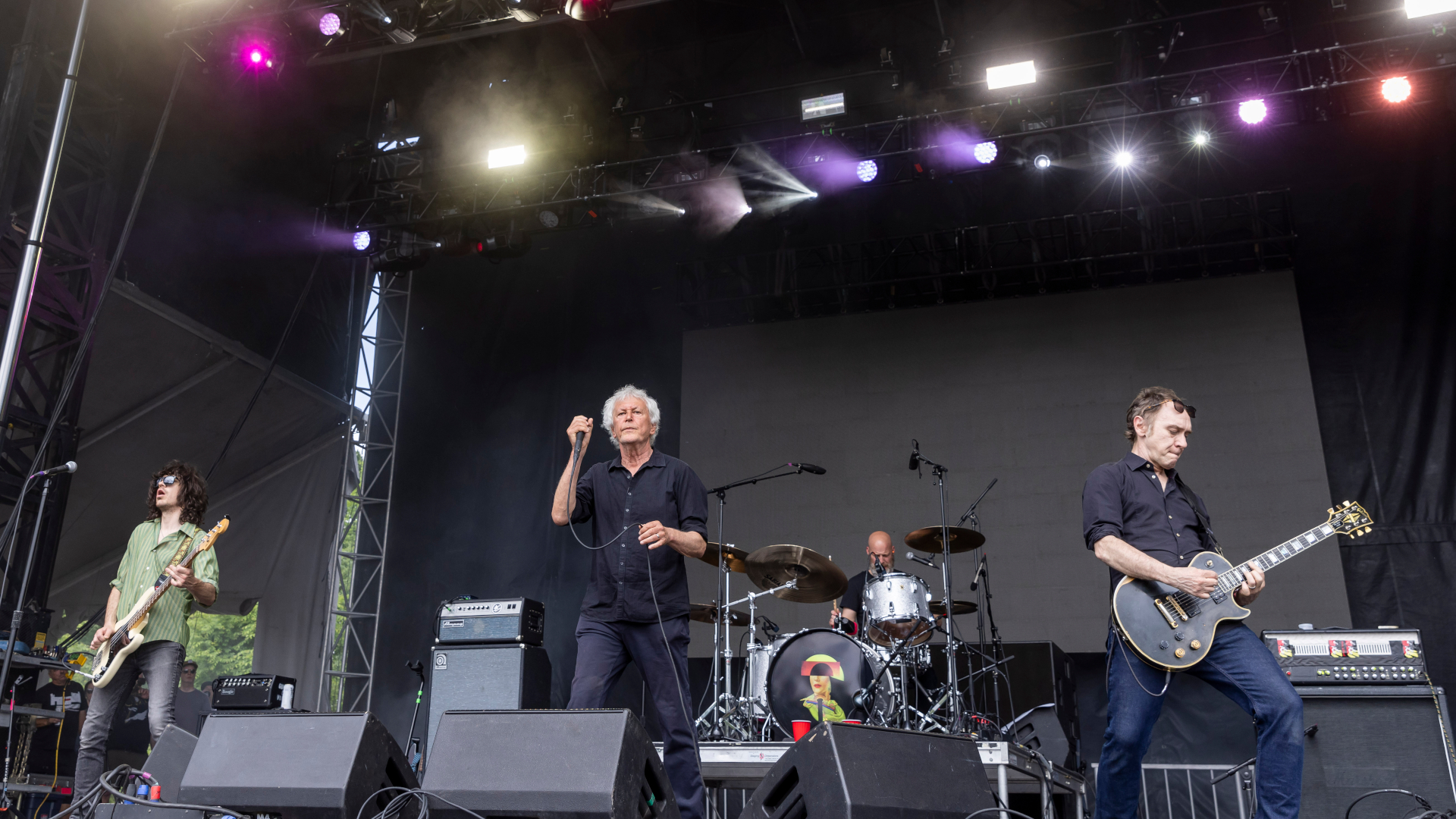
In addition to his work with Guided by Voices — who tour regularly and release albums at the dizzying pace of three per year, the most recent of which is the rousing, rock-forward Strut of Kings (GBV Inc.) — Gillard can be found time-traveling to the dawn of the 1960s with Bambi Kino, a Hamburg-era Beatles tribute band featuring Nada Surf drummer Ira Elliot, Cat Power bassist Erik Paparozzi and noted author/guitarist Mark Rozzo.
“It’s a high-concept tribute band,” Gillard explains. “The conceit is mainly just to play the covers that the Beatles did from 1960 to ’63 at the Cavern Club and in Hamburg, Germany. We throw in a few of their originals, like ‘Cry for a Shadow,’ a very early instrumental John and George wrote. We also play ‘I Saw Her Standing There,’ because it was so heavily influenced by Chuck Berry and was a pivotal song for them, as well as ‘Ask Me Why’ from the Beatles’ Please Please Me album, because it had such a large girl-group influence.”
"Every once in a while you’ll hear him fret some unexpected chord you didn’t know existed."
—Erik Paparozzi
Regardless of which band he’s performing with, Gillard serves the music with originality. “Doug may just be the most musical guitar player I have ever heard,” Paparozzi says. “And in Bambi Kino, he brings all of that musicality to his role but never ever strays from the period of early rock and roll we are honoring.” The bassist also notes that Gillard is a polymath who can play drums and is an excellent bassist and vocal arranger. “But every once in a while, if you’re listening closely, you’ll hear him fret some unexpected chord with open strings that you didn’t know existed, and those moments always make me smile.”
All the latest guitar news, interviews, lessons, reviews, deals and more, direct to your inbox!
Like his peers, Gillard seems secure in the knowledge that he can cut heads with the best of them. Still, at this point in his career, he’s more focused on other aspects of his musicianship. “I don’t really care anymore about being a guitar player of note,” he says. “I’d rather just make good songs and make good music.”

Was guitar your first instrument?
I started by beating on things to try to play drums, but my dad had always played guitar — he was only a hobby player — and I was fascinated with that. He had one of those Kay Thin Twin guitars with the tiger-stripe pickguard that Jimmy Reed used, and he would plug it into his 1955 Montgomery Ward amp. We traded that guitar in around 1974 for a 1972 Gibson SG II.
You started writing songs very early. In fact, Scat Records once released It’ll Be Such a Thrill, a collection of songs that you’d recorded between the ages of about five and nine. How did you get into recording at such an early age?
We were the only house on our road at the time. It was a rural delivery route in sort of the farmlands. Sometimes I would just hike in the cornfields with my dog and make up songs about animals and stuff. My parents got this reel-to-reel recorder to record their voices and airmail tapes back and forth to my sister, who was stationed in Germany at the time, and I started realizing you could use it for musical purposes. I would have my mom turn it on for me and press “record” and “play.” It was very low-fi, but it got the job done. When I was in fifth grade or thereabouts, there was a talent show in my reading class, and for my entry I recorded the backing to “Calling Dr. Love” by Kiss, took the tape to school, played it and played lead guitar as the melody.
"I started by beating on things to try to play drums, but my dad played guitar, and I was fascinated with that."
—Doug Gillard
Besides Kiss, evidently, what other bands or guitarists shaped your playing early on?
I grew up listening to my sister’s early Beatles albums and the Monkees, and there was a Paul Revere & the Raiders album in the house. Also, whatever was on CKLW, which played a pretty well-rounded representation of what was on the charts. [The AM radio station is based in Windsor, Ontario, near Detroit, and has a strong signal.] And when I was at the grocery store with my mom, I saw this album where the cover and its colors were thrilling to look at. And that was Magic Bus by the Who. I actually had them confused with the Guess Who, which CKLW played a lot because they’re Canadian. And so I started to learn Pete Townshend’s style. And then in 1976 or 1977, Frampton Comes Alive! came out, and I just kind of started playing along with the record. It was a very melodic style that I’ve kind of just stuck with.
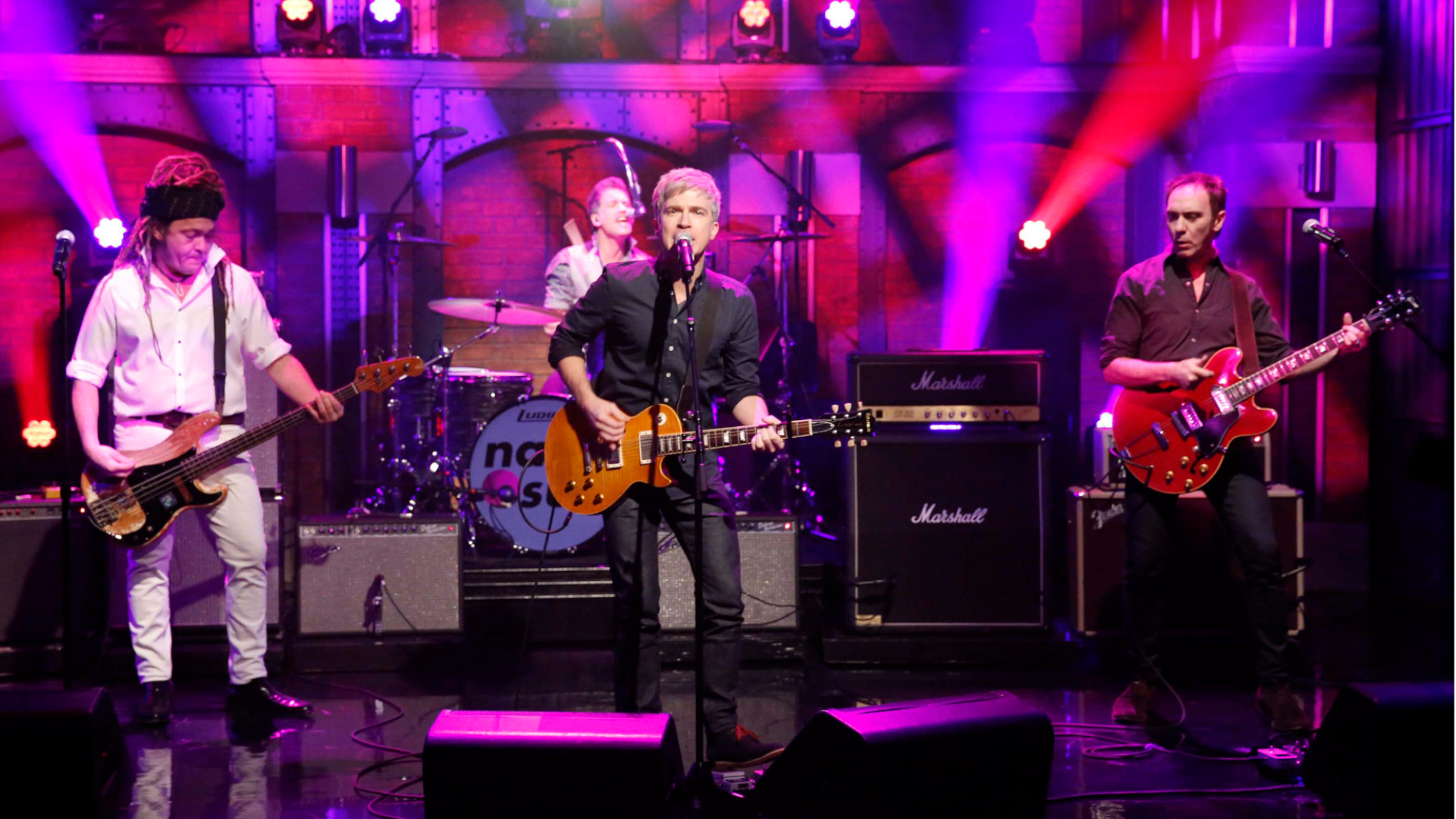
At what point did punk and new wave come into the picture for you?
I started seeing bands on Saturday Night Live and just went, “What the hell is that? That’s amazing!” And because it was so weird, I was just drawn to it. I mean, I’m in a suburb of Cleveland and I’m 12 years old; none of my friends were talking about any of this stuff. But it was on major labels, it was on the radio, and it was on SNL, so it was in the stores. I definitely started to become a devotee of the Cars’ first album and Candy-O. Those were played very often in my room. And I was also just discovering college radio. When I heard XTC’s “Life Begins at the Hop” and “Making Plans for Nigel,” both off their album Drums and Wires, I said, “Okay, that’s it. This is great.”
"My 1976 Les Paul Custom is very heavy, very sturdy, and it’s always been a stalwart companion."
—Doug Gillard
Your black 1970s Les Paul Custom has been your main instrument for decades. How did you happen upon that guitar?
By the time 1985 rolled around, I had been through underground punk and a period where I was really into goth stuff like Siouxsie and the Banshees and Killing Joke. But then I became a DJ at a college radio station and I started getting into Mark Bolan and T. Rex, Bowie’s early stuff with Mick Ronson, Slade, Gary Glitter and the Glitter Band, the Sweet… you name it. I’d see that kind of guitar in so many of those pictures, but I never told myself, I have to get a black Les Paul.
Then I saw a listing in a newspaper called the Tradin’ Times — a black 1976 Les Paul Custom for sale in Akron, Ohio, for $450 — and I drove down to get it. It came with a DiMarzio Super 2 in the bridge that’s still there, and some sort of cream DiMarzio in the neck that I later replaced. That guitar is very heavy, very sturdy, and it’s always been a stalwart companion.
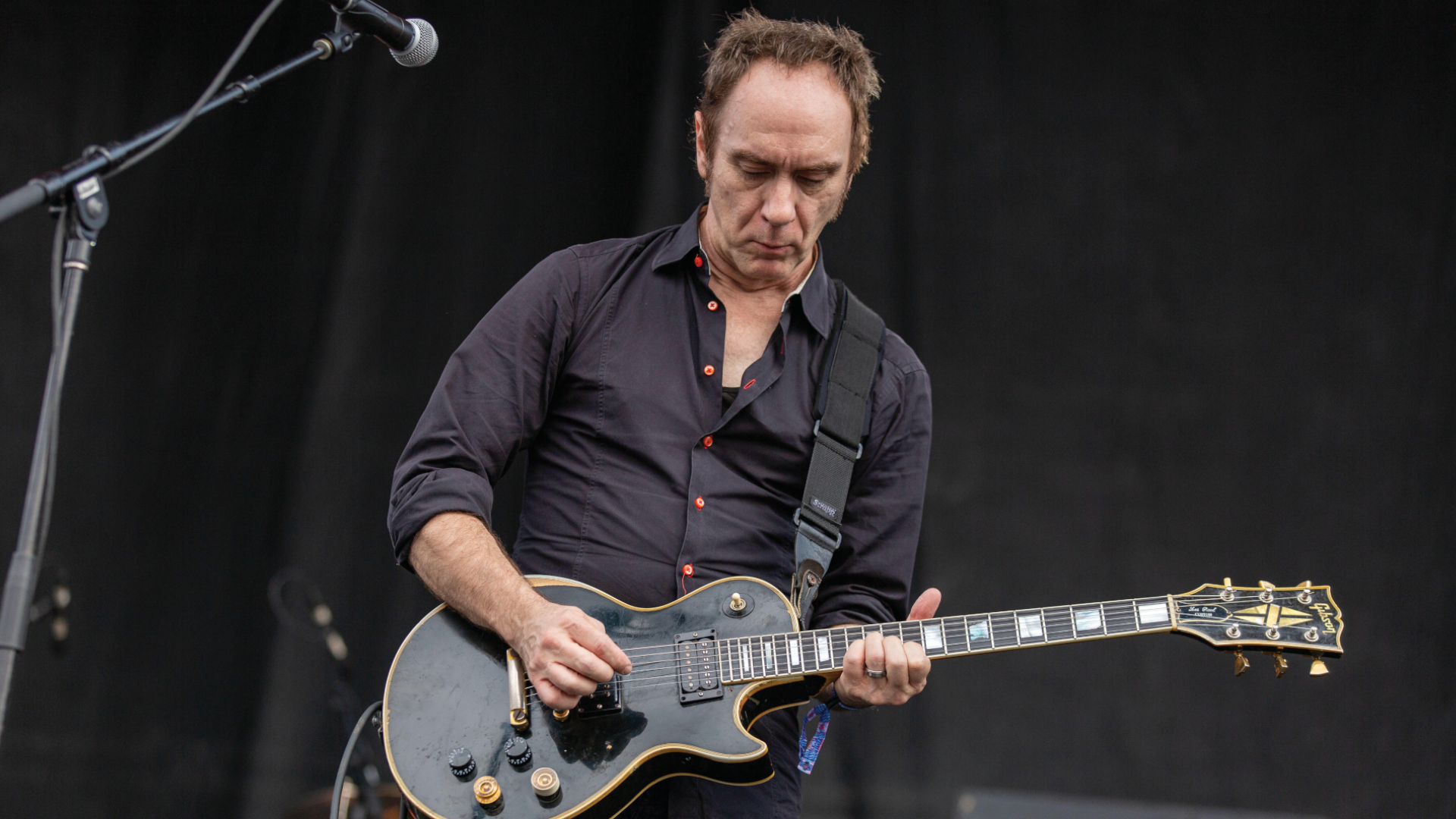
For several decades, you’ve primarily used a Mesa Dual Rectifier, which is an amp much more prevalent in metal than indie and alternative circles.
I know how to work those amps, and I like them because you can use the clean channel for clean, the dirty channel for distortion, and they have a solo channel with a dedicated solo potentiometer. It just boosts whatever channel you’re on exponentially. Most other amps that I know of don’t have that.
Are there any pedals or other effects you’re currently digging?
I’ve been using a Fulltone Deja ’Vibe a lot recently in the studio, doing the basic rhythm tracks through that, but just to add a subtle modulation, which makes things a little more atmospheric. For solos, I really like the EarthQuaker Devices Park Fuzz Sound pedal, and Kogoy Musical Devices made me a great distortion they call the HSL9000. Depending on where you set the preamp bias, it can really get really furry and into Neil Young territory.
"I said, 'Wow, what’s this?' He goes, 'It’s Guided by Voices.' I thought it was really great and different and heard the sense of melody involved."
—Doug Gillard
Do you remember your first encounter with Robert Pollard?
I was at the apartment of Robert Griffin, who owned Scat Records, along with some other people who were stuffing a compilation album I contributed to into envelopes for mail-order customers. We ordered pizza and Robert went over to the turntable and put on either Guided by Voices’ Propeller or Self-Inflicted Aerial Nostalgia, and I said, “Wow, what’s this?” He goes, “It’s this band from Dayton, Ohio, that I’m thinking about signing called Guided by Voices.” I thought it was really great and different and heard the sense of melody involved, and I kind of put it in the back of my mind.
Not too long after that, I was at a party after a show I had played that Bob had been at as well. I was standing in the kitchen talking to him and he told me he liked my band Death of Samantha, and then he sang one of the riffs from the song “The Set-Up (of Madame Sosostris)” to me. And I thought, Wow, that’s really cool.

“I Am a Tree,” with its descending hammered-on intro riff and triumphant solo section, has become your signature song. Did you know you had something special as soon as you wrote it?
I wrote that in 1991 or ’92. It was just one of those nights where I was jamming, coming up with stuff for fun. I had a capo at the seventh fret because I was trying to play “Go Your Own Way” by Fleetwood Mac. And then as I kept playing in that capo position, I started making my own riffs. I didn’t think of it like this at the time but the intro riff is basically just Keith Richards hammer-ons in the fifth-string barre chord position at the ninth fret, and then a couple of Hendrix “Wind Cries Mary” double-stops when you get to the low part. The song was in the set of another band I played in called Gem, but it didn’t end up on our record. So when Guided by Voices were doing Mag Earwig!, Bob said, “You know what? I’ve always liked that one song Gem didn’t do anything with it. We could do it on this record.”
Guided by Voices has such a vast and ever-growing repertoire, and you also play very long sets. How many songs do you have stored in your brain at any given time that you can play on the spot?
We do about 50 songs per show and usually have about 60 or 70 ready to go. If it’s not in the batch of songs we’re drawing from at the time, it’s not in my mind. But if it’s not in the set and Bob for some reason gets a wild notion and says, “You know what? Let’s play ‘Quality of Armor’ right now,” or something like “Postal Blowfish,” I can do that because it’s a one-note song. But anything else, I’d need to re-learn unless it was something I was really involved with recording from the ground up, like Mag Earwig!, Do the Collapse and a couple records after that.
"The intro riff is just Keith Richards hammer-ons and then a couple of Hendrix 'Wind Cries Mary' double-stops."
—Doug Gillard
Do you improvise much live?
I do like to improvise live if possible. I don’t want to stray away from the chords, but if it’s a lead section, and especially if it’s a lead that I made up, I will. When we make the records, the songs aren’t lived-in yet, and the concern is to nail the parts and be true to the way they were written. And then, after you’re playing them live for a while, you discover new possibilities in the songs and the embellishments start happening. Vocalists do that all the time too.
You’re very involved in the production of the current Guided by Voices albums, including the newest release, Strut of Kings. Can you describe how they’re made and your role in the process?
Bob, who is in Dayton, Ohio, initially records himself on a cassette playing acoustic and singing. And then he has his own self-editing process where he will take a CD burner and maybe cut in a different section to the song here and there, also from a cassette. Our producer and engineer Travis Harrison, who is in New York, will get those demos and kind of put everything on a grid, which we can choose to use or not. He will give us cleaned-up demos without click and demos with click. There are songs on the records where we don’t record together as a whole band. And sometimes we do. Most albums are a hybrid.
You do some guitar tracks at home through the amp simulators in GarageBand, correct?
Given that Guided by Voices used to record in Bob’s basement in the early ’90s, I think any level of technology, low or high, is allowed in this band. That said, I liked going to Travis’s studio to track the guitars through an amp and a speaker and a microphone, because you really get the best results that way.
"I liked going to Travis’s studio to track the guitars through an amp and a speaker and a microphone, because you really get the best results that way."
—Doug Gillard
And you also arrange the strings and other instrumentation and generate those tracks in GarageBand?
Exactly. On my own songs, I’ll do arrangements if they call for it, and if there are strings in a Guided by Voices song, they are per Bob’s production notes. If he hears a horn or a string somewhere or a string section or something, he’ll put it in the notes, and I’ll just go from there and then come up with something. I never know what the end result will be: I’ll start with the central part and then I’ll just kind of build around it and hopefully know when to stop at some point.
Are there specific ways that you modify your playing to channel an 18-year-old George Harrison in Bambi Kino?
I know what to prevent myself from playing. There are certain types of vibrato that you don’t use. And that era of music employed different chord shapes. There’s a lot of sevenths, and I’ve had to learn to play a lot of the tops of chords. So it’s pretty much the opposite of the way I’ve played my whole life.

